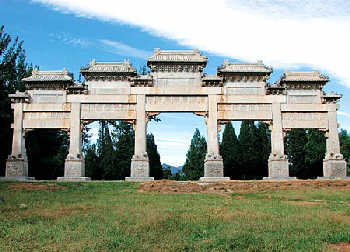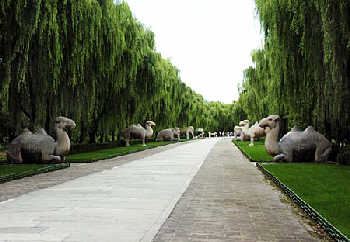
Paifang at the Ming Tombs

Shixiangsheng
Ming Dynasty tombs are located in two places. One is at the southern foot of Zhongshan Mountain in Nanjing, and is called Ming Xiaoling Mausoleum of Zhu Yuanzhang. The other is at the foot of Tianshou Mountain in north Changping, Beijing, where 13 emperors after Zhu Di are buried, and called the Ming Tombs.
Under the Ming tomb system, grave mounds are changed into round earth mounds, called "baoding" or tee. The front axis of the tee is a series of courtyards which emphasizes the in-depth composition of the axis. Such a design, which is more compact, is a good concept. on both sides of the path leading to the Ming tombs are many stone carvings, calledShixiangsheng.
What is more noteworthy is that the method of group layout of the Ming Tombs is a great creation. Prior to this, the various tombs were built independently, unrelated to each other. The Ming Tombs adopt the method of construction placing the Changing Tomb of Emperor ChengZu at the center. Various other tombs formed an arc shape and jointly used the Shinto (path leading to tombs), not only reducing manual work, but also increasing the momentum of the tomb area.
The Tianshou Mountain where the Ming Tombs are located is within Changping County, 45 km to the north of Beijing. The winding mountain ridges linked to each other create a horseshoe shape opening to the south. At the northernmost center of the horseshoe, the Chengzu Changling Tomb is built at the foot of the mountain. At the opening of the horseshoe, six km south of Changling Tomb, there are two east and west sm8ll isolated hills opposite to each other. The Dahongmen, built between them, is taken as the starting-point of the entire mausoleum area. This method of using natural terrain reminds people of the fine tradition that ancient Chinese cities and other large structures pay close attention to integration with the macro-environment. Apart from the Changling Tomb, another 12 tombs are scattered along the two sides of the horseshoe facing the path leading to public tombs.

Copyright ©1999-2011 Chinanews.com. All rights reserved.
Reproduction in whole or in part without permission is prohibited.